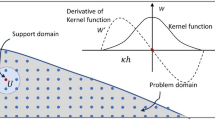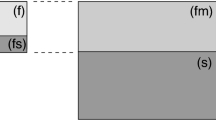Abstract
This paper builds on the flexibility of the level-set representation to model in a unified manner the expansion of a hollow in the ground under different physical phenomena. In particular, the dissolving action of a flow of water in a saturated soil, and that of a jet of particles of water in a non-saturated one, are represented in a common framework. In that manner, the complex geometrical evolutions of the hollow can be followed without the need for remeshing and this approach allows for a smooth transition between saturated and non-saturated models of the soil. Implementation and numerical difficulties are discussed and two applications of industrial interest are considered. The first one describes the modeling of the piping phenomenon, and the second one the evolution of an excavation created by a leaking duct.
Similar content being viewed by others
References
Crank J (1984) Free and moving boundary problems. Oxford University Press, Oxford
Unverdi SO, Tryggvason G (1992) A front-tracking method for viscous, incompressible, multi-fluid flows. J Comput Phys 100(1): 25–37. doi:10.1016/0021-9991(92)90307-K
Gorczyk W, Gerya TV, Connolly JA, Yuen DA, Rudolph M (2006) Large-scale rigid-body rotation in the mantle wedge and its implications for seismic tomography. Geochem Geophys Geosyst 7(5):Q05,018. doi:10.1029/2005GC001075
Jan YJ (2007) A cell-by-cell thermally driven mushy cell tracking algorithm for phase-change problems. Comput Mech 40(2): 201–216. doi:10.1007/s00466-006-0098-x
van Keken PE, King SD, Schmeling H, Christensen UR, Neumeister D, Doin MP (1997) A comparison of methods for the modeling of thermochemical convection. Phys Fluids A 102(B10):22, 477–22, 496. doi:10.1029/97JB01353
Sethian JA (1999) Level set methods and fast marching methods. Cambridge University Press, Cambridge
Osher S, Fedkiw RP (2001) Level set methods: an overview and some recent results. J Comput Phys 169(2): 463–502. doi:10.1006/jcph.2000.6636
Osher S, Sethian JA (1988) Fronts propagating with curvature-dependent speed: algorithms based on Hamilton–Jacobi formulations. J Comput Phys 79(1): 12–49. doi:10.1016/0021-9991(88)90002-2
Sussman M, Smereka P, Osher S (1994) A level set approach for computing solutions to incompressible two-phase flow. J Comput Phys 114(1): 146–159. doi:10.1006/jcph.1994.1155
Mulder W, Osher S, Sethian JA (1992) Computing interface motion in compressible gas dynamics. J Comput Phys 100(2): 209–228. doi:10.1016/0021-9991(92)90229-R
Karlsen KH, Lie KA, Risebro NH (2000) A fast marching method for reservoir simulation. Comput Geosci 4(2): 185–206. doi:10.1023/A:1011564017218
Nielsen LK, Li H, Tai XC, Aanonsen SI, Espedal M (2008) Reservoir description using a binary level set model. Comput Vis Sci. doi:10.1007/s00791-008-0121-1
Zlotnik S, Díez P, Fernández M, Vergés J (2007) Numerical modelling of tectonic plates subduction using X-FEM. Comput Methods Appl Mech Eng 196(41–44): 4283–4293. doi:10.1016/j.cma.2007.04.006
Zlotnik S, Fernández M, Díez P, Vergés J (2008) Modelling gravitational instabilities: slab break-off and Rayleigh–Taylor diapirism. Pure Appl Geophys 165: 1–20. doi:10.1007/s00024-004-0386-9
Sethian JA, Popovici AM (1999) 3-D traveltime computation using the fast marching method. Geophysics 64(2): 516–523. doi:10.1190/1.1444558
Ito K, Kunisch K, Li Z (2001) Level-set function approach to an inverse interface problem. Inverse Probl 17(5): 1225–1242. doi:10.1088/0266-5611/17/5/301
Burger M (2001) A level set method for inverse problems. Inverse Probl 17(5): 1327–1355. doi:10.1088/0266-5611/17/5/307
Burger M, Osher SJ (2005) A survey of level set methods for inverse problems and optimal design. Eur J Appl Math 16(2): 263–301. doi:10.1017/S0956792505006182
Bonelli S, Brivois O, Borghi R, Benahmed N (2006) On the modelling of piping erosion. Comptes-Rendus Mécanique 334(8–9): 555–559. doi:10.1016/j.crme.2006.07.003
Wan CF, Fell R (2004) Investigation of rate of erosion of soils in embankment dams. J Geotech Geoenviron Eng ASCE 130(4): 373–380. doi:10.1061/(ASCE)1090-0241(2004)130:4(373)
Wan CF, Fell R (2004) Laboratory tests on the rate of piping erosion of soils in embankment dams. Geotech Testing J 27(3): 1–9. doi:10.1520/GTJ11903
Zlotnik S, Díez P (2009) Hierarchical X-FEM for n-phase flow (n > 2). Comput Methods Appl Mech Eng 198(30-32): 2329–2338. doi:10.1016/j.cma.2009.02.025
Darcy H (1856) Les Fontaines Publiques de la Ville de Dijon. Dalmon, Paris
Bear J, Bachmat Y (1999) Introduction to mmodeling of transport phenomena in porous media. In: Bear J (eds) Theory and applications of transport in porous media, vol 4. Kluwer Academic Publishers, Dordrecht, p 136
Knapen A, Poesen J, Govers G, Gyssels G, Nachtergaele J (2007) Resistance of soils to concentrated flow erosion: a review. Earth-Science Rev 80(1–2): 75–109. doi:10.1016/j.earscirev.2006.08.001
Vardoulakis I, Stavropoulou M, Papanastasiou P (1996) Hydro-mechanical aspects of the sand production problem. Transp Porous Media 22(2): 225–244. doi:10.1007/BF01143517
Vardoulakis I, Papanastasiou P, Stavropoulou M (2001) Sand erosion in axial flow conditions. Transp Porous Media 45(2): 267–280. doi:10.1023/A:1012035031463
Giménez R, Govers G (2002) Flow detachment by concentrated flow on smooth and irregular beds. Soil Sci Soc Am J 66: 1475–1483
Woodward DE (1999) Method to predict cropland ephemeral gully erosion. CATENA 37(3-4): 393–399. doi:10.1016/S0341-8162(99)00028-4
Sidorchuk A (2005) Stochastic components in the gully erosion modelling. CATENA 63(2–3): 299–317. doi:10.1016/j.catena.2005.06.007
Donea J, Huerta A (2003) Finite element methods for flow problems. John Wiley & Sons Ltd, Chichester
Adalsteinsson D, Sethian JA (1999) The fast construction of extension velocities in level set methods. J Comput Phys 148(1): 2–22. doi:10.1006/jcph.1998.6090
Russo G, Smereka P (2000) A remark on computing distance functions. J Comput Phys 163(1): 51–67. doi:10.1006/jcph.2000.6553
Rouy E, Touring A (1992) A viscosity solutions approach to shape-from-shading. SIAM J Numer Anal 29(3): 867–884. doi:10.1137/0729053
Budyn E, Hoc T, Jonvaux J (2008) Fracture strength assessment and aging signs detection in human cortical bone using an X-FEM multiple scale approach. Comput Mech 42(4): 579–591. doi:10.1007/s00466-008-0283-1
Yvonnet J, Quang HL, He QC (2008) An XFEM/level set approach to modelling surface/interface effects and to computing the size-dependent effective properties of nanocomposites. Comput Mech 42(1): 119–131. doi:10.1007/s00466-008-0241-y
Gross S, Reusken A (2007) Finite element discretization error analysis of a surface tension force in two-phase incompressible flows. SIAM J Numer Anal 45(4): 1679–1700. doi:10.1137/060667530
Legrain G, Moës N, Huerta A (2008) Stability of incompressible formulations enriched with X-FEM. Comput Methods Appl Mech Eng 197(21–24): 1835–1849. doi:10.1016/j.cma.2007.08.032
Bligh WG (1910) Dams, barrages and weirs on porous foundations. Eng News 64: 708
Lane EW (1935) Security from under-seepage masonry dams on earth foundations. Trans ASCE 100: 1235–1351
Koenders MA, Sellmeijer JB (1992) A mathematical model for piping. J Geotechn Eng 118(6): 943–946. doi:10.1061/(ASCE)0733-9410
Ojha CS, Singh VP, Adrian DD (2003) Determination of critical head in soil piping. J Hydraulic Eng ASCE 129(7): 511–518. doi:10.1061/(ASCE)0733-9429
Bonelli S, Brivois O (2008) The scaling law in the hole erosion test with a constant pressure drop. Int J Numer Analytical Methods Geomech 32(13): 1573–1595. doi:10.1002/nag.683
Lachouette D, Golay F, Bonelli S (2008) One-dimensional modeling of piping flow erosion. Comptes-Rendus Mécanique 336(9): 731–736. doi:10.1016/j.crme.2008.06.007
Burns B, Barker R, Ghataora GS (2006) Investigating internal erosion using a miniature resistivity array. NDT & E Int 39(2): 169–174. doi:10.1016/j.ndteint.2004.12.009
Author information
Authors and Affiliations
Corresponding author
Additional information
The support of Gas Natural Distribución SDG S.A. and Ministerio de Educación y Ciencia de España, through grants DPI2007-62395 and BIA2007-66965, is gratefully acknowledged.
Rights and permissions
About this article
Cite this article
Cottereau, R., Díez, P. & Huerta, A. Modeling, with a unified level-set representation, of the expansion of a hollow in the ground under different physical phenomena. Comput Mech 46, 315–327 (2010). https://doi.org/10.1007/s00466-009-0443-y
Received:
Accepted:
Published:
Issue Date:
DOI: https://doi.org/10.1007/s00466-009-0443-y




